|
|
|
Sort Order |
|
|
|
Items / Page
|
|
|
|
|
|
|
| Srl | Item |
| 1 |
ID:
109916
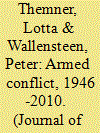

|
|
|
|
|
| Publication |
2011.
|
| Summary/Abstract |
In 2010, UCDP recorded 30 active armed conflicts (i.e. with a minimum of 25 battle-related deaths). This is a substantial reduction in relation to the 36 conflicts registered for 2009. A drop of this magnitude has only been reported four times previously in the post-1946 period. However, only in two of these instances was this part of a general downward trend. Thus no major inferences should be drawn, except perhaps that the reduction in conflicts in Africa seems to be part of a trend. At 30 in 2010, the number of active conflicts is at its lowest level since 2003. Furthermore, the number of wars (1,000 or more battle-related deaths) declined from six in 2009 to four in 2010. The most intense war in terms of fatalities was in Afghanistan. Eight of the armed conflicts listed for 2009 were not active in 2010, but during the year two new conflicts erupted - Mauritania and Tajikistan - both involving rebel groups that had previously fought in neighbouring countries. Only two peace agreements were concluded during the year. While this is one more than 2009, it is decidedly below the annual average for the post-Cold War period.
|
|
|
|
|
|
|
|
|
|
|
|
|
|
|
|
| 2 |
ID:
098418
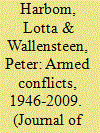

|
|
|
|
|
| Publication |
2010.
|
| Summary/Abstract |
In 2009, UCDP recorded 36 active armed conflicts, down by one from 2008. Having remained fairly stable over the past few years, the number of armed conflicts is now substantially lower than during the peak years of the early 1990s. But compared to the early years of this decade, the figure has increased by 24%. Six of the conflicts reached the level of war (more than 1,000 battle-related deaths) in 2009, up by one from 2008. No interstate conflict was recorded, but seven intrastate conflicts were internationalized, in the sense that one or both of the conflict parties received troops support from an external state. The most intense war in terms of fatalities was that in Sri Lanka. Eight of the armed conflicts listed for 2008 were not active in 2009, but during the year, one entirely new conflict erupted in Myanmar (Kokang), two were restarted by previously recorded actors in Angola (Cabinda) and in Rwanda and four previously recorded conflicts were restarted by new actors in Central African Republic, India (Bodoland), Nigeria and Yemen. Only one peace agreement was concluded during the year, which is decidedly lower than the annual average recorded for the past 20 years.
|
|
|
|
|
|
|
|
|
|
|
|
|
|
|
|
| 3 |
ID:
117019


|
|
|
|
|
| Publication |
2012.
|
| Summary/Abstract |
In 2011, the Uppsala Conflict Data Program (UCDP) recorded 37 armed conflicts with a minimum of 25 battle-related deaths. This significant increase from the 31 conflicts recorded in 2010 was primarily driven by an increase in conflicts on the African continent, and is only in part due to events tied to the Arab Spring which mostly led to other forms of violence than conventional armed conflict. The number of active conflicts still remains at a relatively low level compared to the peak years in the early 1990s, when more than 50 conflicts were active. The number of wars - conflicts leading to 1,000 or more battle-related deaths - increased to six; however, it is a considerably lower number than during the peak years of the early 1990s. For the second consecutive year, Afghanistan claimed the highest number of fatalities. Five armed conflicts listed for 2010 were not active in 2011, but during the year three new conflicts erupted - Libya, South Sudan and Sudan (Abyei) - and six conflicts already registered were restarted. Only one peace agreement was concluded during the year. Thus, the trend with low numbers of peace accords which started in 2009 continues.
|
|
|
|
|
|
|
|
|
|
|
|
|
|
|
|
| 4 |
ID:
122902
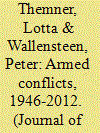

|
|
|
|
|
| Publication |
2013.
|
| Summary/Abstract |
In 2012, the Uppsala Conflict Data Program (UCDP) recorded 32 armed conflicts with a minimum of 25 battle-related deaths. This is a significant decrease from the 37 recorded in 2011. Overall, the 2000s has been the least conflict-ridden decade since the 1970s. A worrying finding, however, is that the number of internationalized intrastate conflicts continued to be at a high level for the fourth consecutive year. At six, the number of wars - conflicts leading to 1,000 or more battle-related deaths - remained the same as in 2011. In total, UCDP estimates that the conflicts that were active in 2012 caused between 37,175 (low estimate) and 60,260 (high estimate) battle-related deaths, with a best estimate of 37,941. The conflict that caused the highest number of fatalities in 2012 is the Syrian conflict, which led to between 14,830 (low) and 30,805 (high) battle-related deaths, with the best estimate being 15,055. Eleven armed conflicts listed in 2011 were not active in 2012; however, three new conflicts erupted during the year - India (Garoland), Mali and South Sudan vs. Sudan (common border) - and three previously registered conflicts were resumed by new actors. Lastly, 2012 saw an increase in the number of signed peace agreements which had been at a very low level over the past three years; four accords were concluded during the year, compared with one in 2011.
|
|
|
|
|
|
|
|
|
|
|
|
|
|
|
|
| 5 |
ID:
092637
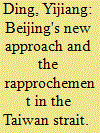

|
|
|
| 6 |
ID:
189656


|
|
|
|
|
| Summary/Abstract |
Extensive research has been conducted in the field of peacebuilding concerning the role of civil society in peace negotiations. However, although research has stressed the importance of coordination among civil society groups, we have limited knowledge concerning the impact civil society coordination can have on the content of a peace agreement. This article addresses this gap by examining how the extent of coordination among civil society groups during peace negotiations influences the reflectiveness of a peace agreement in regard to civil society viewpoints. We argue that a high extent of coordination, where civil society actors coordinate tasks and spearhead viewpoints together, can help facilitate peace agreements that are more reflective of civil society group views. Based on a comparative analysis of Guatemala and El Salvador, the findings show that whereas coordination between different civil society groups was quite extensive in both peace processes, civil society viewpoints were inscribed into the peace agreement to a larger extent in the Guatemalan case. We identify two factors that contribute in shaping how coordination influences the content of peace accords: symmetrical transfer of information, and openness from the negotiation parties to consider suggestions from civil society.
|
|
|
|
|
|
|
|
|
|
|
|
|
|
|
|
| 7 |
ID:
047101


|
|
|
|
|
| Publication |
Geneva, United Nations Institute for Disarmament Research, 2000.
|
| Description |
xv, 206p.
|
| Standard Number |
9290451378
|
|
|
|
|
|
|
|
|
|
|
|
Copies: C:2/I:0,R:0,Q:0
Circulation
| Accession# | Call# | Current Location | Status | Policy | Location |
| 044300 | 303.609664/AYI 044300 | Main | On Shelf | General | |
| D44300 | 303.609664/AYI D44300 | Main | On Shelf | General | |
|
|
|
|
| 8 |
ID:
087293
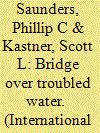

|
|
|
|
|
| Publication |
2009.
|
| Summary/Abstract |
In Taiwan's 2008 presidential election, both candidates advocated signing a peace agreement with China, and Chinese leaders have also expressed interest in reaching such an agreement. Although substantial obstacles remain in the way of a cross-strait peace agreement, this increased interest on both sides of the Taiwan Strait suggests that a closer examination of an agreement's possible dimensions and consequences is warranted. This analysis considers what an agreement might look like, whether and how it might be effective in reducing the possibility of cross-strait military conflict, the relevant barriers to an agreement, and whether an agreement-if reached-would be likely to endure.
|
|
|
|
|
|
|
|
|
|
|
|
|
|
|
|
| 9 |
ID:
091338


|
|
|
|
|
| Publication |
2009.
|
| Summary/Abstract |
Early on the morning of 17 May 1983, representatives of Lebanon, Israel and the United States gathered for a ceremony in the hamlet of Khalde, several kilometres south of Beirut. The ceremony marked the signing of an Israeli-Lebanese peace agreement intended to end Israel's then one-year-old war in Lebanon.
|
|
|
|
|
|
|
|
|
|
|
|
|
|
|
|
| 10 |
ID:
189965


|
|
|
|
|
| Summary/Abstract |
Commitment problems make civil wars difficult to end. Research on overcoming commitment problems focuses on warring parties, however civilians’ perceptions are central to successful transitions from war to peace. While civilians residing in areas previously controlled by armed groups may be highly distrustful that governments will implement peace agreements, I argue that some armed groups are both motivated and capable of improving trust in the state. Using survey data from civilians in the Bangsamoro, Philippines, I show that civilians that experienced rebel security provision or rebel justice provision from the MILF are more likely to trust that the Government of the Philippines will fully implement the peace agreement than civilians that did not experience rebel governance provision.
|
|
|
|
|
|
|
|
|
|
|
|
|
|
|
|
| 11 |
ID:
185192


|
|
|
|
|
| Summary/Abstract |
This article examines how leaders affect the implementation of peace agreements. It argues that implementation is more likely when leaders have publicly committed to peace because public commitments tie leaders’ hands, making it costly to back down from peaceful promises. This effect is hypothesized to hold even under conditions that make implementation costly: when implementing difficult provisions, when spoiler risk is high, and when implementation is unreciprocated. These expectations are tested using novel data from the IPAD dataset on the implementation of peace agreements between 1989 and 2014 and on public statements by state and rebel leaders. Results show that governments and rebel groups whose leaders have publicly committed to peace are significantly more likely to make progress toward implementation. This effect holds for difficult provisions, when spoiler risk is high, and when implementation is unreciprocated. These findings highlight the importance of leaders’ political will for successful implementation of peace agreements and sustainable peace.
|
|
|
|
|
|
|
|
|
|
|
|
|
|
|
|
| 12 |
ID:
157510


|
|
|
|
|
| Summary/Abstract |
Disputants might resolve their disagreements in a piecemeal fashion, addressing a subset of the issues at a time. How viable is such a strategy? I argue that partial settlements signal the desire to resolve disagreements and can lay the foundation for additional cooperation by building trust and/or demonstrating the benefits of dispute resolution. As a result, partial settlements should be associated with the resolution of remaining disagreements. Yet, scholars have questioned whether pursuing a piecemeal approach may be more harmful than helpful, and a systematic empirical test of these competing predictions is necessary. Using data from worldwide territorial claims between 1919 and 2001, I find a strong positive correlation between partial settlements and comprehensive dispute resolution. In the shorter run, partial settlements are also associated with an increased likelihood for peaceful negotiations, but there is only limited evidence that they reduce conflict before all aspects of the claim are resolved.
|
|
|
|
|
|
|
|
|
|
|
|
|
|
|
|
| 13 |
ID:
187388
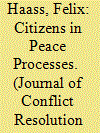

|
|
|
|
|
| Summary/Abstract |
Citizen engagement in and support for peace processes have been deemed important for sustainable peace after civil wars. Yet much of what we know about peace processes in civil wars centers on the interests of elite actors. This special feature aims to advance a research agenda focusing on citizens in peace processes to address this mismatch. In the introduction to the special feature, we first present empirical evidence situating citizens in relation to civil war peace processes. We then trace the current state of the literature on the roles of citizens in peace processes. Following that, we introduce a conceptual framework designed to improve scholarly analysis of the political behavior of citizens in peace processes. We also locate the individual contributions to the special feature within the framework in order to demonstrate its utility and as a means of helping to identify directions for future research.
|
|
|
|
|
|
|
|
|
|
|
|
|
|
|
|
| 14 |
ID:
178671
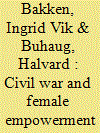

|
|
|
|
|
| Summary/Abstract |
Recent research has directed attention to the transformative potential of war for female empowerment. As a disruptive shock, armed conflict can create a window of opportunity for advancing the societal role of women. We complement this research agenda by looking at how conflict severity and termination condition the outcomes for women in the aftermath of civil conflict. We expect that both level of violence and mode of resolution affect subsequent female empowerment, where severe conflicts ending by a negotiated settlement have the greatest transformative potential. Consistent with expectations, we find that post-conflict improvements in female empowerment occur primarily after high-intensity civil conflicts. However, subsequent tests reveal that this effect is driven largely by conflicts terminated by peace agreements. The greatest improvement in female empowerment is seen when peace agreements have gender-specific provisions. These results support calls for a sustained effort toward mainstreaming gender issues in conflict resolution and peacebuilding processes.
|
|
|
|
|
|
|
|
|
|
|
|
|
|
|
|
| 15 |
ID:
190434


|
|
|
|
|
| Summary/Abstract |
While a growing body of research has highlighted a significant and positive relationship between negotiated peace agreements and postwar democratization, they have focused almost exclusively on a minimalist form of electoral democracy. We extend this analysis to consideration of how civil war outcomes affect egalitarian democracy, which measures the extent to which the regime incorporates (1) equal protection of rights and freedoms, (2) equal distribution of resources, and (3) equal access to power. We add V-Dem egalitarian democracy measures to the UCDP Conflict Termination dataset to determine whether civil war outcomes account for just the emergence of electoral democracy or whether they also affect the prospects for a more just and equitable society for citizens at the grassroots level. Our findings highlight the need to qualify the effect of modes of war termination on postwar democratization. Peace agreements are followed by higher levels of democratization than is the case with other civil war outcomes, but the effect on egalitarian democracy is more durable than the effect on electoral democracy.
|
|
|
|
|
|
|
|
|
|
|
|
|
|
|
|
| 16 |
ID:
151289


|
|
|
| 17 |
ID:
095670
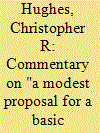

|
|
|
|
|
| Publication |
2010.
|
| Summary/Abstract |
This critique assesses Prof. Chang Ya-chung's draft basic agreement for cross-Strait relations by arguing that it overstates changes in Beijing's Taiwan policy, which is based on a strategy that has not seen substantial change since it was devised in the early 1990s to prevent the island's democratization leading to the exercise of self-determination. By over-estimating Taiwan's political, diplomatic, military, and economic vulnerability the proposal unnecessarily narrows down Taibei's options to the point where it has to accept Beijing's one-China principle. This merely closes off other options that Taiwan can just as readily pursue, such as continuing to develop cross-Strait relations through ad hoc solutions to practical problems or seeking more imaginative ways to create a durable modus vivendi with international support. Even more problematic is that a political framework for stability based on the principles of Chinese nationalism is unlikely to be acceptable for Taiwan's liberaldemocratic politics and could thus amount to an unnecessary risk that would lead to a less durable cross-Strait status quo than that which has been maintained over the last two decades.
|
|
|
|
|
|
|
|
|
|
|
|
|
|
|
|
| 18 |
ID:
113043
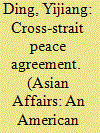

|
|
|
|
|
| Publication |
2012.
|
| Summary/Abstract |
In spite of the fact that substantial progress has been made in the improvement of relations between China and Taiwan, 1
there have been no talks on sensitive political issues. Beijing's proposal for a cross-strait peace agreement is put on hold. Disagreement over the sovereignty of one China and the political reality in Taiwan have conspired to create an apparent impasse and contributed to an indefinite delay of the negotiations. At the moment, a large section of Taiwanese people do not seem to want this peace agreement. The ruling Chinese Nationalist Party (KMT) cannot afford to start negotiations without a strong domestic consensus. This article examines the political situation in Taiwan, analyzes the main obstacles to reaching a cross-strait peace agreement, and explores possible solutions.
|
|
|
|
|
|
|
|
|
|
|
|
|
|
|
|
| 19 |
ID:
074502
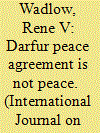

|
|
|
| 20 |
ID:
104281
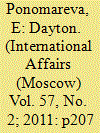

|
|
|
|
|
| Publication |
2011.
|
| Summary/Abstract |
Dayton, Ohio, is home to a U.S. Air Force base and undoubtedly one of the symbols of the new world order. Alongside Brussels, The Hague, Strasbourg, and Rambouillet, it is associated with redealing out cards of History and reestablishing rules of the political game. You will recall that the General Framework Agreement for Peace in Bosnia and Herzegovina (Dayton Agreement) was initialed on November 21, 1995. The Agreement went into effect on December 14, 1995 after its signing in Paris. Its guarantors were the USA, UK, France, Germany, and Russia. The coming into force of this Agreement put an end to the armed confrontation in Bosnia and Herzegovina in 1992-1995; it separated the warring sides and set apart territories of the Republika Srpska and the Muslim-Croat Federation.
|
|
|
|
|
|
|
|
|
|
|
|
|
|
|
|
|
|
|
|
|